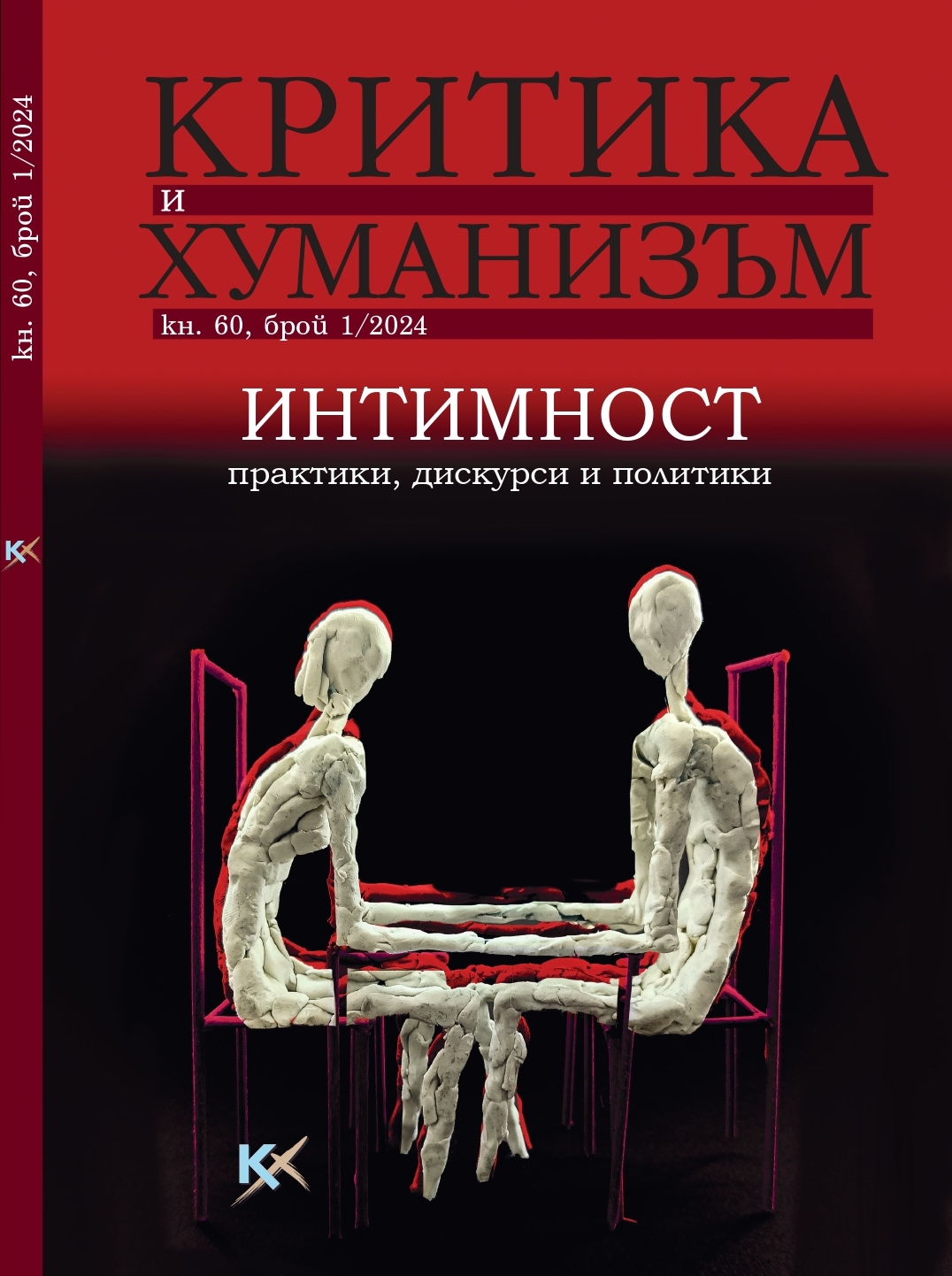
сп. Критика и хуманизъм | кн. 60, бр. 1/2024 | Интимност: практики, дискурси и политики
водещи броя: Гергана Ненова, Татяна Коцева и Вероника Димитрова, кн. 60, бр. 1/2024, с. 332, ISSN:0861-1718
Съдържание
* Изданието е достъпно на български език.
Уводни думи
Тематичният брой „Интимност: практики, дискурси и политики“ це- ли да отговори на предизвикателствата на бързо променящите се социо- културни измерения на интимността, като предложи различни теоретични и емпирични перспективи към нея. Амбицията му е не само да допринесе към научното познание на тази проблематика в български контекст, но и да създаде и консолидира академична общност, подготвена да се включи в международните научни дебати. Текстовете са обединени в пет тема- тични блока – „Интимността като теоретичен терен“, „Дигитални интим- ности“, „Рискове на интимността“, „Етнос и интимност“ и „Юношество и интимност“.
Издаването на този брой е възможно благодарение на финансовата подкрепа на Фонда за научни изследвания на МОН в рамките на проекта „Култури, практики и рискове на интимността на младите хора в Бълга- рия“ (2023–2026) (договор КП-06-Н65/8 от 12.12.2022 г., ръководител Гер- гана Ненова).
Интимността като теоретичен терен
Социологическите подходи към интимността – в търсене на теория на средно равнище
Abstract: The article explores the different theoretical understandings and approaches to intimacy inherent in the fields of family sociology, sociology of love and sociology of intimacy. A theoretical differentiation of three ideal-typical models of intimacy is proposed and elaborated – codified intimacy, democratic intimacy, and everyday intimacy. Codified intimacy includes the culturally established ideas and practices around love, democratic intimacy – the cultural ideal of equality in the intimate relations, and everyday intimacy – the habitual ways and meanings of „doing intimacy“ and creating coupledom in everyday life. The contemporary intimate relations of young people in Bulgaria are viewed as located at the intersection of these three types of intimacy.
Keywords: intimacy, intimate relationships, love
Да бъдеш собственост, да бъдеш интимна: брак и гражданство
Abstract: This paper explores the nexus between marriage and citizenship. Its basic assumption is that, historically, marriage imposed limits on the right to equal participation in citizenship for women. In order to support this hypothesis, modes of historical formation of marriage are examined, first in the Middle Ages, then in the era of so-called abstract equality, and finally in the 19th century, when citizenship had been established as a political institution. Marriage as a legal institution is situated within the historical development of the public and the private, and the transformation of absolute rights of persons. The paper focuses on the state of coverture: the situation of married women in Anglo-Saxon legislature. This examination of the specificities of the dual development of private persons finds that the specific position of married women not only delayed their acquisition of the status of citizen, but also remained deeply interwoven in the texture of citizenship itself.
Кeywords: citizenship, marriage, women, privacy, property, representation
Рискове на интимността
Уязвимата интимност: рискове и несигурност в интимните отношения на младите хора в България
Abstract: The current article presents some outcomes of a qualitative study among female victims of domestic violence, police officers and experts from sheltering services in Bulgaria. Eight focused groups, from four different regions, with 63 respondents were developed by a Grounded-theory analysis. The finding shows “mistrust in the system” as a core concept, shared by all types of respondents in all discussion settings. The axial codes include systematic, cultural, and personal nodes. The basic barriers at that level include: “negative previous experience”, “cumbersome procedures”, “rushed protection”, “mutual negative stereotypes”, “professional culture” [of the police officers], “revictimization”, “inefficient protection”, “concerns about the future quality of life”, and “severe social vulnerability”. Some limitations of the study such as non- selection bias of non-reported IPV cases, underreported violence against male partners, and IPV cases in LGBTQ+ communities, as well as lack of focused group with healthcare providers are discussed at the end of the article.
Keywords: gender-based intimate partner violence, violence against women, domestic abuse in Bulgaria
„Навират те в устата на вълка“ (Бариери при идентификацията и разследването на насилието срещу жени в България, когато е упражнено от интимния им партньор)
Abstract: Based on a conceptual framework for detraditionalization and individualization as characteristics of change in intimacy in global societies (U. Beck, E. Beck-Gernsheim, Z. Baumann, A. Giddens, E. Illouz), this article aims to understand how young people in Bulgaria conceptualize the risks and uncertainties in their intimate relationships. As an additional interpretative code, we use the idea of overlapping and co-existence of elements of traditional, modern and postmodern relationships, through which the traditional values of lasting and monogamous relationships based on romantic love coexist with free choices for personal self-realization, dignity and satisfaction with the quality of intimate relationships. The risks we analyze based on an empirical qualitative study are in two areas: in terms of digital communication and dating, and in terms of non-traditional forms of intimacy associated with polyamory, multiple relationships, and casual sexual contacts. The analysis shows that young people associate risks in the digital environment with deceptive and manipulable pro- files, limited means of expression for emotional communication, devaluation of relationships, as well as sexual messages on social media.
Keywords: intimacy, sexuality, risks, insecurity, digital communication, polyamory, infidelity, one-night stands/casual sex, young people, Bulgaria
„Токсичната връзка“ в пресечната точка на търсенето на „себе си“ и на равенство: употреби на категорията „токсичен“ в разказите на младите хора за интимността
Abstract: The article explores the premises of the popular notion of toxic relationship and the way they express and sustain the cultural contradictions of intimacy in late modernity. Through analysis of the multifaceted meanings and uses of the term “toxic” in the interviews with young people aged 16 to 26 the study elucidates the way they are permeated with the ideas of self-discovery and equality in relationships. The various uses of “toxic” reflect the contradictory place of “the self” both as a center and as a problem in intimate relations, as well as the persistent gender inequality manifested in controlling behaviours, abuse and violence.
Keywords: toxic relationship, intimacy, youth, equality